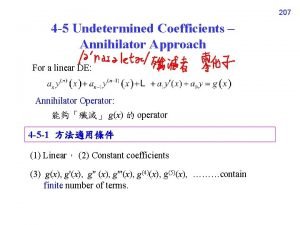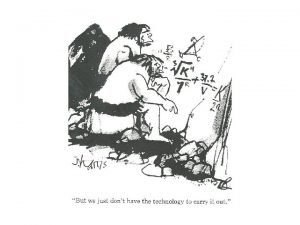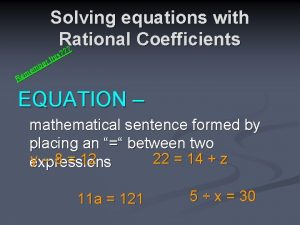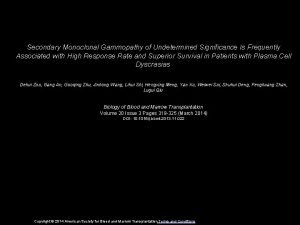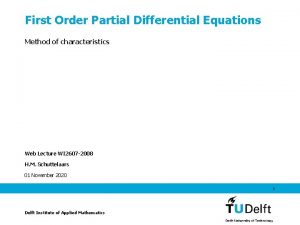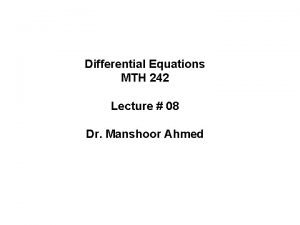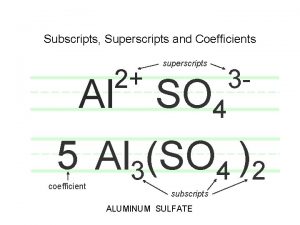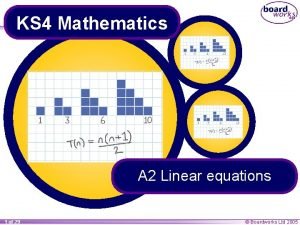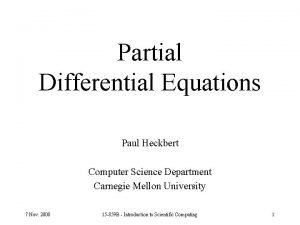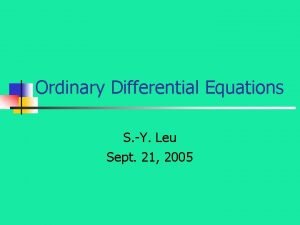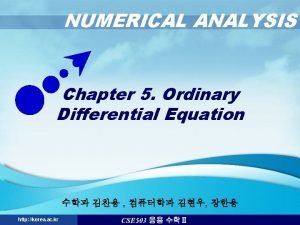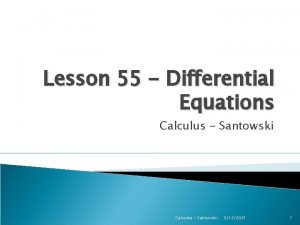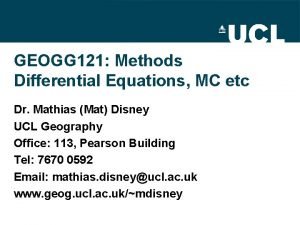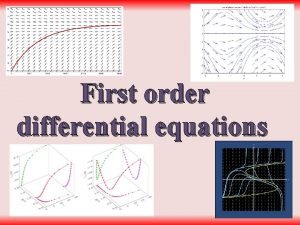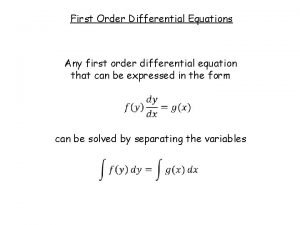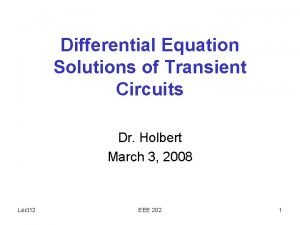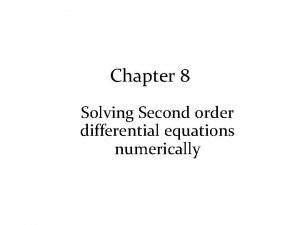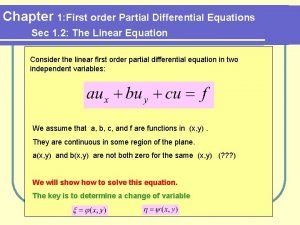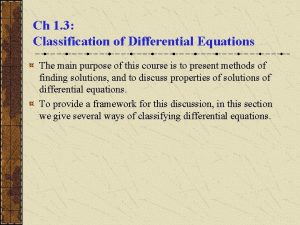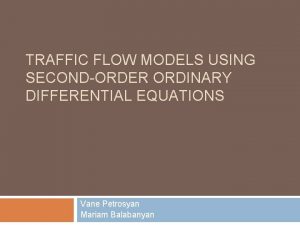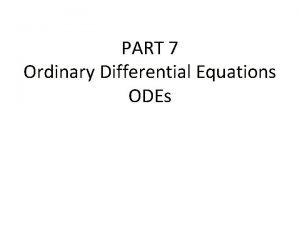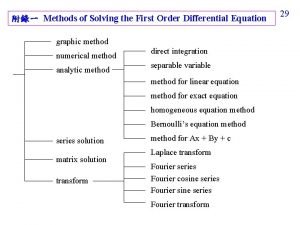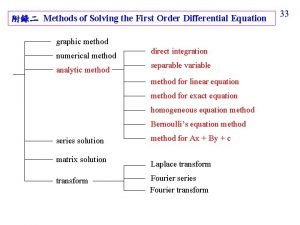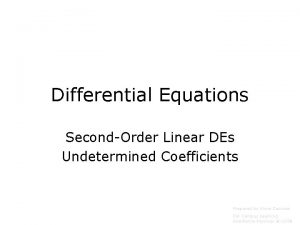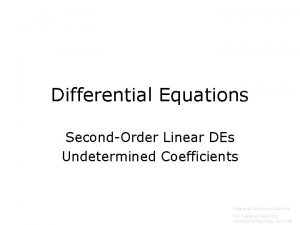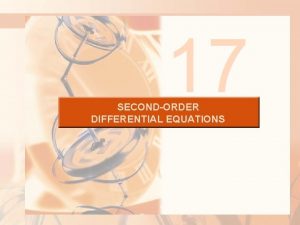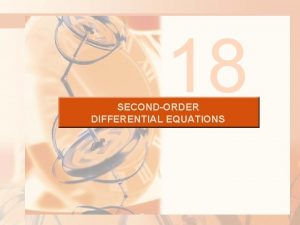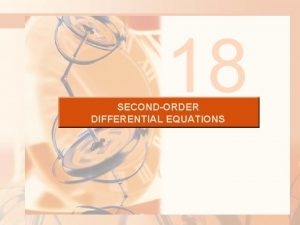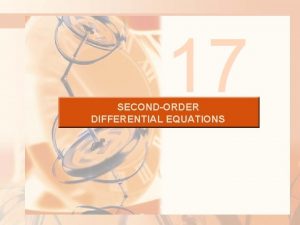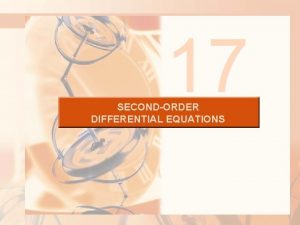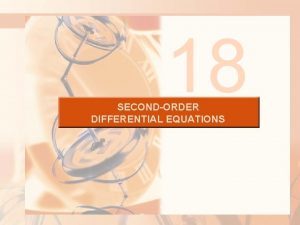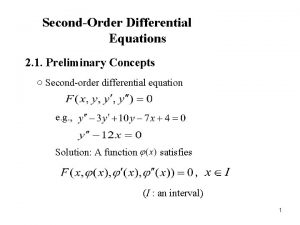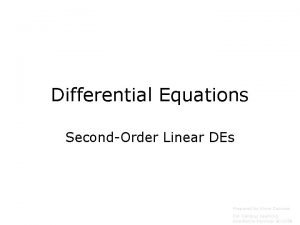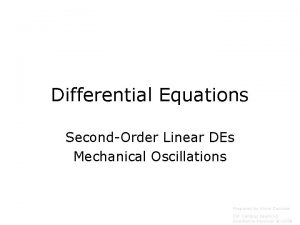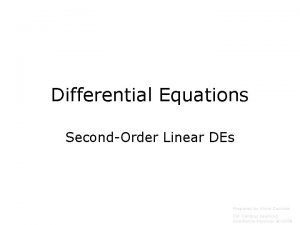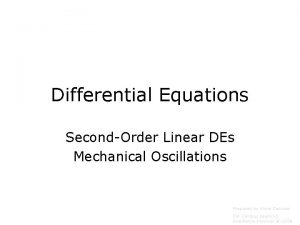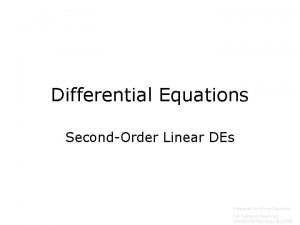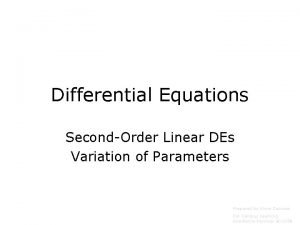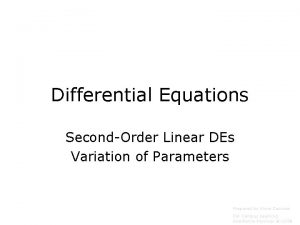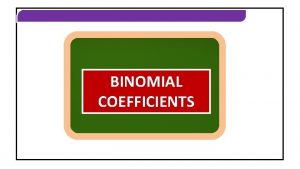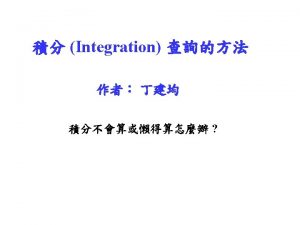Differential Equations SecondOrder Linear DEs Undetermined Coefficients Prepared




































- Slides: 36

Differential Equations Second-Order Linear DEs Undetermined Coefficients Prepared by Vince Zaccone For Campus Learning Assistance Services at UCSB

A Second-Order Linear Differential Equation can always be put into the form: The general solution will always have the form: yh is the solution to the corresponding homogeneous equation, where g(t)=0 yp is a particular solution to the original DE. There should be two independent solutions to the homogeneous equation, and yh will be a linear combination of these two. In fact, the two independent solutions form a basis for a 2 dimensional solution space (an actual vector space like we saw last quarter). Prepared by Vince Zaccone For Campus Learning Assistance Services at UCSB

If the function on the right side is a polynomial, exponential, or sine/cosine function then we can use the method of undetermined coefficients to find a particular solution. The basic idea is to guess the form of the particular solution to be a general version of the g(t) function, then plug into the original D. E. to determine the coefficients in the guess. Here a few examples of what to use for the guess: Note that for each guess, all possible terms in the derivatives of the basic guess have to be accounted for. This is why (At 2+Bt+C) must be used, even though the g(t) function only has a t 2 term. Prepared by Vince Zaccone For Campus Learning Assistance Services at UCSB

There is one more difficulty to consider to make sure your guess is going to work. Make sure the guess does not contain a solution to the homogeneous equation. This is why the yh must be found before plugging in to find the coefficients. In the equation below, the initial guess matches one of the homogeneous solutions, so the guess must be modified by multiplying by t. The initial guess for the particular solution is: Find the homogeneous solutions in the usual way, then compare. The initial guess for yp matches up with these solutions, so modify it: Part of this new guess for yp still matches up, so modify it again: Finally, none of this matches yh so it will work. Prepared by Vince Zaccone For Campus Learning Assistance Services at UCSB

Here a few examples of inhomogeneous linear second order D. E. s with constant coefficients. These equations are all Inhomogeneous. The homogeneous solution must be found first, then the particular solution can be obtained by the method of undetermined coefficients. Prepared by Vince Zaccone For Campus Learning Assistance Services at UCSB

First find the solution to the associated homogeneous problem. Prepared by Vince Zaccone For Campus Learning Assistance Services at UCSB

First find the solution to the associated homogeneous problem. Prepared by Vince Zaccone For Campus Learning Assistance Services at UCSB

First find the solution to the associated homogeneous problem. The homogeneous solution is Prepared by Vince Zaccone For Campus Learning Assistance Services at UCSB

First find the solution to the associated homogeneous problem. The homogeneous solution is Now make a guess for the particular solution. If the g(t) function on the right side is nice enough (polynomial, exponential or sine or cosine) then the guess will be a general version of what is there. In this case the guess is: Prepared by Vince Zaccone For Campus Learning Assistance Services at UCSB

First find the solution to the associated homogeneous problem. The homogeneous solution is Now make a guess for the particular solution. If the g(t) function on the right side is nice enough (polynomial, exponential or sine or cosine) then the guess will be a general version of what is there. In this case the guess is: Our task is to find the constants A, B and C that match up with the D. E. Prepared by Vince Zaccone For Campus Learning Assistance Services at UCSB

The homogeneous solution is Compute the derivatives, then plug into the D. E. Prepared by Vince Zaccone For Campus Learning Assistance Services at UCSB

The homogeneous solution is Compute the derivatives, then plug into the D. E. Prepared by Vince Zaccone For Campus Learning Assistance Services at UCSB

The homogeneous solution is Compute the derivatives, then plug into the D. E. Prepared by Vince Zaccone For Campus Learning Assistance Services at UCSB

The homogeneous solution is Compute the derivatives, then plug into the D. E. Organize the left side by powers of t, then match up with the right side. Prepared by Vince Zaccone For Campus Learning Assistance Services at UCSB

The homogeneous solution is Prepared by Vince Zaccone For Campus Learning Assistance Services at UCSB

The homogeneous solution is Matching coefficients yields 3 equations in 3 unknowns: Prepared by Vince Zaccone For Campus Learning Assistance Services at UCSB

The homogeneous solution is Matching coefficients yields 3 equations in 3 unknowns: A bit of algebra and the coefficients are Prepared by Vince Zaccone For Campus Learning Assistance Services at UCSB

The homogeneous solution is The particular solution is Add these together to get the general solution to the D. E. Prepared by Vince Zaccone For Campus Learning Assistance Services at UCSB

Now add some initial conditions. Prepared by Vince Zaccone For Campus Learning Assistance Services at UCSB

Now add some initial conditions. We will need to determine the constants in our general solution that match up with the given conditions. Prepared by Vince Zaccone For Campus Learning Assistance Services at UCSB

Now add some initial conditions. We will need to determine the constants in our general solution that match up with the given conditions. A bit of algebra gives Prepared by Vince Zaccone For Campus Learning Assistance Services at UCSB

Now add some initial conditions. We will need to determine the constants in our general solution that match up with the given conditions. A bit of algebra gives Here is our final solution. Prepared by Vince Zaccone For Campus Learning Assistance Services at UCSB

Prepared by Vince Zaccone For Campus Learning Assistance Services at UCSB

The homogeneous solution was found in the previous example: The initial guess for the particular solution is based on the function on the right side of the D. E. : Check this against the homogeneous solutions. If it matches then this guess will not work for the particular solution. Modify the guess by multiplying by t: This is linearly independent from the homogeneous solutions so it should work. Prepared by Vince Zaccone For Campus Learning Assistance Services at UCSB

The homogeneous solution was found in the previous example: Compute the derivatives and plug in to find the value of the coefficient. After simplifying, solve for A. general solution Prepared by Vince Zaccone For Campus Learning Assistance Services at UCSB

Prepared by Vince Zaccone For Campus Learning Assistance Services at UCSB

This was solved previously. Initial guess for particular solution: This does not match the homogeneous solutions, so it should work nicely. After finding the derivatives and plugging in, the results are A=0, B=-1/3. general solution Prepared by Vince Zaccone For Campus Learning Assistance Services at UCSB

Prepared by Vince Zaccone For Campus Learning Assistance Services at UCSB

The homogeneous solution is: Prepared by Vince Zaccone For Campus Learning Assistance Services at UCSB

The homogeneous solution is: A guess for the particular solution is Compare to the homogeneous solution and none of the terms are repeated here. The exponential term makes the homogeneous solutions linearly independent from these. Prepared by Vince Zaccone For Campus Learning Assistance Services at UCSB

The homogeneous solution is: A guess for the particular solution is Compare to the homogeneous solution and none of the terms are repeated here. The exponential term makes the homogeneous solutions linearly independent from these. Prepared by Vince Zaccone For Campus Learning Assistance Services at UCSB

The homogeneous solution is: A guess for the particular solution is Compare to the homogeneous solution and none of the terms are repeated here. The exponential term makes the homogeneous solutions linearly independent from these. Prepared by Vince Zaccone For Campus Learning Assistance Services at UCSB

The homogeneous solution is: A guess for the particular solution is Compare to the homogeneous solution and none of the terms are repeated here. The exponential term makes the homogeneous solutions linearly independent from these. Prepared by Vince Zaccone For Campus Learning Assistance Services at UCSB

The homogeneous solution is: A guess for the particular solution is Compare to the homogeneous solution and none of the terms are repeated here. The exponential term makes the homogeneous solutions linearly independent from these. Prepared by Vince Zaccone For Campus Learning Assistance Services at UCSB

The general solution is: Plug in the given values to find c 1 and c 2. Prepared by Vince Zaccone For Campus Learning Assistance Services at UCSB

The general solution is: Plug in the given values to find c 1 and c 2. Prepared by Vince Zaccone For Campus Learning Assistance Services at UCSB
 Cauchy euler equation
Cauchy euler equation Lagrange undetermined multipliers
Lagrange undetermined multipliers Solving linear equations with rational coefficients
Solving linear equations with rational coefficients Numbers in tagalog
Numbers in tagalog Monoclonal gammopathy of undetermined significance
Monoclonal gammopathy of undetermined significance Method of characteristics pde second order
Method of characteristics pde second order Differential equations
Differential equations Munthe sizing
Munthe sizing Higher order linear differential equations
Higher order linear differential equations Subscript in
Subscript in Solve equations with rational coefficients
Solve equations with rational coefficients Solving equations with fractional coefficients
Solving equations with fractional coefficients Des des des
Des des des Penyelesaian persamaan simultan
Penyelesaian persamaan simultan Difference between linear and non linear equation
Difference between linear and non linear equation Simultaneous equations linear and non linear
Simultaneous equations linear and non linear Differential equations projects
Differential equations projects Ordinary differential equations ppt
Ordinary differential equations ppt Differential equations pauls
Differential equations pauls Cengage differential equations
Cengage differential equations Ordinary sy
Ordinary sy Euler midpoint method
Euler midpoint method Differential calculus
Differential calculus Partial differential equation
Partial differential equation Separation of variables
Separation of variables Find the general solution of the differential equation
Find the general solution of the differential equation Solving 1st order differential equations
Solving 1st order differential equations Cengage differential equations
Cengage differential equations Transient solution differential equations
Transient solution differential equations Second order differential equation
Second order differential equation Pde first order
Pde first order Definition and classification of differential equations
Definition and classification of differential equations Traffic flow differential equations
Traffic flow differential equations Midpoint method formula
Midpoint method formula What is modified euler method
What is modified euler method First order condition
First order condition Variable separable
Variable separable
